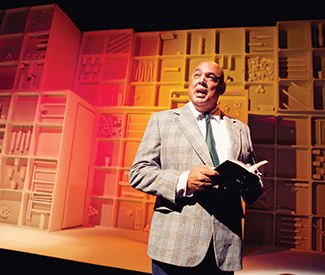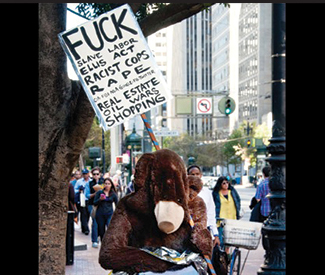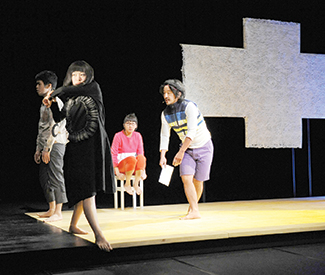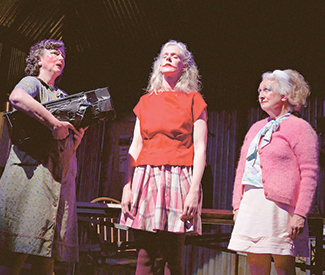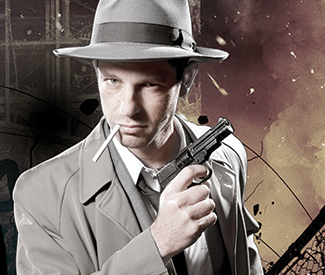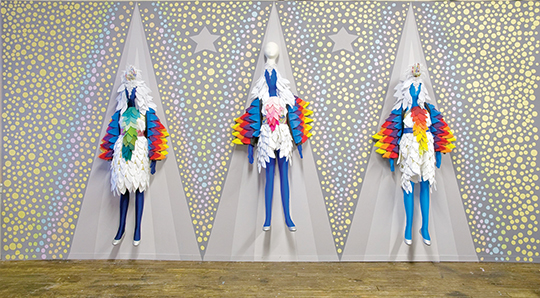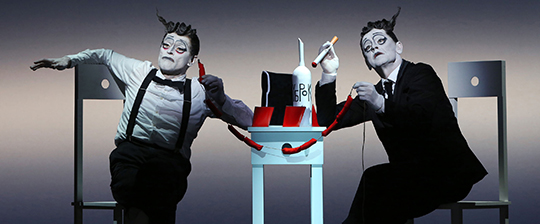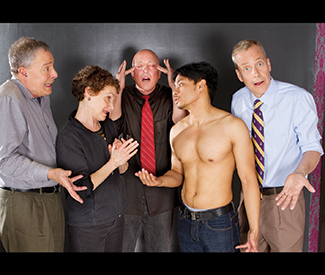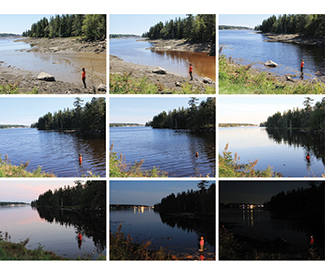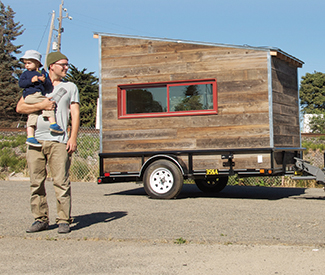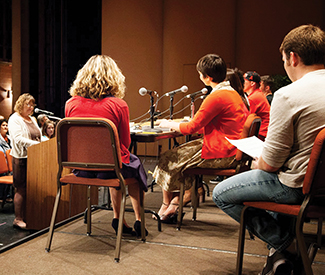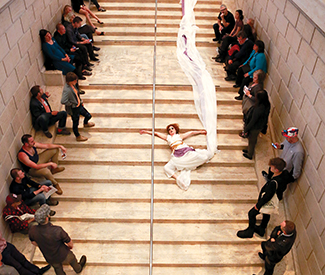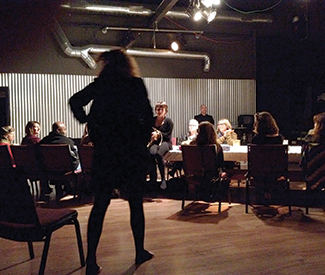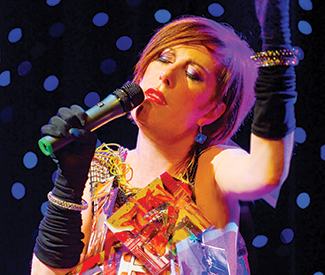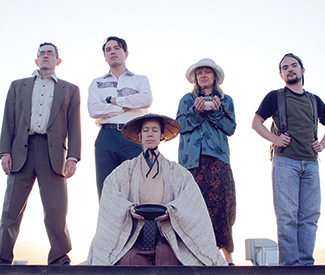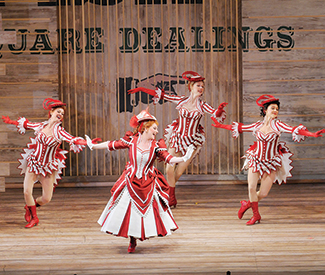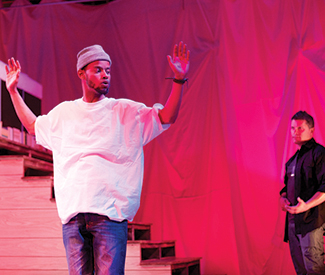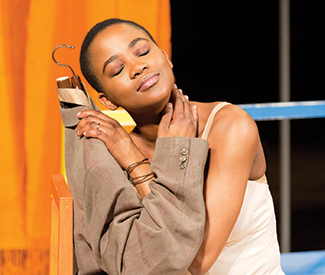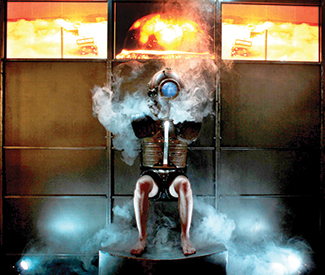arts@sfbg.com
THEATER Mike Daisey is a talker. He can talk about a lot of things. Hell, he can talk for 24 hours straight (and did in All the Hours in the Day at Portland’s TBA Festival in 2011). This gift of gab has brought him acclaim as an artist in the theater, where he’s known as an eminent monologist of the desk-bound Spalding Gray school. In one case, it’s even brought him public scandal, to wit, NPR’s 2012 call-out regarding fabricated bits in The Agony and the Ecstasy of Steve Jobs — an experience Daisey says has made him not only “wiser” but “a better storyteller.”
But Daisey doesn’t tell stories for the sake of talking alone. He chases after questions that intrigue him, and these, more than his comically barbed but affable stage persona, make his stories worth listening to. Occupying a fertile middle ground between high concept and low humor, his self-referential yarns confront issues he sees as central to how we live and — in a related, no less passionate way — to how the theater lives and dies in American culture. He directly essayed this latter theme in his 2008 show, How Theater Failed America, but it remains a lively concern, as he suggests below.
His latest, American Utopias, makes its Bay Area debut at Yerba Buena Center for the Arts this weekend. Following the format he has been honing since the late 1990s, Daisey uses a few notes written on loose sheets of paper to re-create afresh each night a set of three intertwining stories about Disney World, Burning Man, and Occupy Wall Street, following all three down their respective rabbit holes to glean what, individually and cumulatively, they might teach us about ourselves.
SF Bay Guardian You grew up in a really remote corner of the country. When you consider what brought you to where you’re at now, how much of that do you attribute to this background?
Mike Daisey I grew up in a place called Fort Kent, Maine, which is on the Canadian border. It’s actually the end of US Route 1, which begins in Key West. To me, psychically, it always feels like this must be the most remote place possible because every piece of mythology about roads is that sort of Tolkien idea, “The road goes ever on!” Whereas I was like, “No, it doesn’t actually. It ends. Right here. This must be the furthest place from everything.” It’s a very interesting area, the St. John Valley, around the St. John River. The people are predominately French Canadian. It’s a very different place from what I’ve come to recognize as the rest of America.
I do think that there’s a storytelling tradition that grows up in Maine, that exists there, that informs the work I do now. I think partly it’s informed by years of speech and debate at a very tender age. I think it’s informed by a couple of years of playing Dungeons & Dragons at a formative time. And, layered on top of all of that, was a very earnest desire to discover a form that would allow me to create theatrical experiences that were new in the moment that they were spoken. I was really dedicated to that proposition, that there could be a form of theater that lives in the moment that it’s spoken, both for the performer and the audience. I was looking for a form that would allow both there to be rigor and precision in the structure, but at the same time allow true spontaneity, and allow discoveries to happen in the moment that could not be anticipated.
That’s what I love about the monologues, about all storytelling. I often think of jazz when I’m trying to explain it to people. In the Western tradition, it is hard for people to understand how it is that something is composed without being written. We’ve all become so mired in the tyranny of the written word that we actually come to believe that the act of writing is the act of thinking. The spoken work is actually closer to the thought; it’s a more primal form than the form that writing takes. We forget that. So it’s hard to explain to people sometimes how something [spontaneous] can have form and precision and texture and depth. People often want to know, “How long did you work on this monologue?” And there really is no right answer to give, except the one that the jazz legends often give, which is to say, my whole life.
SFBG Do you think that that fascination with the research and work that goes into a piece is part of the way art gets commercialized, packaged as discrete products?
MD Yeah, I think that’s true. You know, I just went to Cuba. I was in Havana for about two weeks. I’m working on what’s going to be a separate piece, from the show that I’m bringing to Yerba Buena, about the commodification of art. When art transforms into a good. As soon as it does, as soon as it enters that market place, we really want to know its provenance; we want to know that this piece was not just tossed off by the artist. We want to know that the artist was thinking about something, or dreaming about something. We want to know that the piece we’re holding is a piece of the artist’s greatness and is an important piece at that. A lot of what it’s about is really acquisitive in nature.
That’s one of the reasons my going to Cuba was so fascinating. Being in a culture where a ballet dancer is paid the same amount that a surgeon is paid is really fascinating for what it does to cultural priorities. I’m not even saying that we all should pay surgeons the same amount as ballet dancers. But coming from my own culture, which I think is anti-art — I think it’s heavily tilted against art because of a real grain of Puritanism that runs through the center of the American character — it’s really fascinating to think about different ways that lives could be lived. Watch me: I’m slowly dovetailing! That connects to American Utopias in a really direct way. A lot of that monologue is about the effort to imagine a different way of life.
SFBG Where does theater figure in that imagining?
MD Theater really needs to make more radical shifts if it wants to take back some ground in the cultural conversation. Not necessarily in a traditional way, opening large movies that everyone’s talking about, but in a quieter way. I feel like theater sometimes suffers from being neither fish nor fowl. I’m often struck by the difference between a play [that’s considered a success] with 400, 500 performances. But those numbers don’t compare to millions of page views on YouTube.
At the same time, there’s another unique number, which is one, like when I create a show that’s for one night only and only happens once. There’s uniqueness to that, which the American theater also has a hard time [working] with because the form involves playwrights and rehearsals — we have a hard time doing the unique event. So instead we have this weird compromise, where we create this unique event but we then do this unique event 23 times. There’s this very odd middle ground. I often feel a correspondence between those numbers: like a run of 23 or 31 performances and page views of seldom-visited pages on the Internet. It’s really hard to thrive when you’re not doing something that’s singular each time and, at the same time, you’re not doing something that’s digital and ubiquitous and anyone can watch anywhere.
I just wish theater would grapple with one world or the other. I feel sometimes like the theater is a little bit its own version of The Glass Menagerie. It’s ignoring the war, everything that’s going on outside, like Tom talks about in his opening monologue of that beautiful play. But then the whole play is in this apartment, in this world where everyone’s dreams become sort of curdled and small. I sometimes feel like we really need to break out of the apartment. We all need to be like Tom and we need to hit the road.
SFBG Given it has three very different strands to it, what is American Utopias ultimately about?
MD American Utopias is about how we create spaces. But not just in the traditional architectural terms, but how we create them socially. So it’s an examination of three very different types of spaces. In each case, the members of the community that have made that space think of it as a kind of utopia. They see it as a reflection of a more perfect world. In many cases they wish they could live there more of the time but they know it’s not possible. I have preferences among the three to some extent but, on the other hand, none of the three are really my utopia. As a consequence, my role, I feel, is to talk about the connections between them. What really interests me are the anthropological systems, how humans organize themselves and how we share dreams. That interests me a lot. *
AMERICAN UTOPIAS
Fri/16-Sat/17, 7:30pm, $30-$35
Yerba Buena Center for the Arts Theater
700 Howard, SF
www.ybca.org

